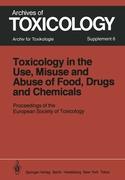Toxicology in the Use, Misuse, and Abuse of Food, Drugs, and Chemicals
BücherAngebote / Angebote:
Many chemotherapeutic agents introduced for use in humans are carcinogenic in laboratory animals (Conklin et al. 1965, Shimkin et al. 1966, Griswold et al. 1968, Harris 1976). However, initially their beneficial effect in disseminated cancer was of such short duration that the inevitable death of the patient from his primary disease precluded any clinical manifestation of the carcinogenic potential. During the last decade, chemotherapy has radically changed the outlook for many patients with cancer. Combinations of drugs, administered as the primary treatment, have resulted in high rates of cure in patients with disseminated malignancies, such as stage IV Hodgkin's disease or childhood acute lymphocytic leukemia. In other disseminated forms of neoplasia, induction of a remission, a substantial palliation and a prolongation of survival have been achieved. In many instances of localised disease, where surgery with or without radiotherapy are the primary form of treatment, anticancer drugs have been used with success as adjuvant therapy for distant microscopic disease. With these spectacular achievements, secondary malignancies, in particular acute non-lymphocytic leukemia (ANLL), has become of major concern. Incidence Acute leukemia is the most frequent form of secondary neoplasia in patients treated for cancer (Penn 1981). In one large series, 5. 9% of all ANLL could be attributed to previous chemotherapy (Kapadia et al. 1980).
Folgt in ca. 5 Arbeitstagen
